Salby M.L. Fundamentals of Atmospheric Physics
Подождите немного. Документ загружается.

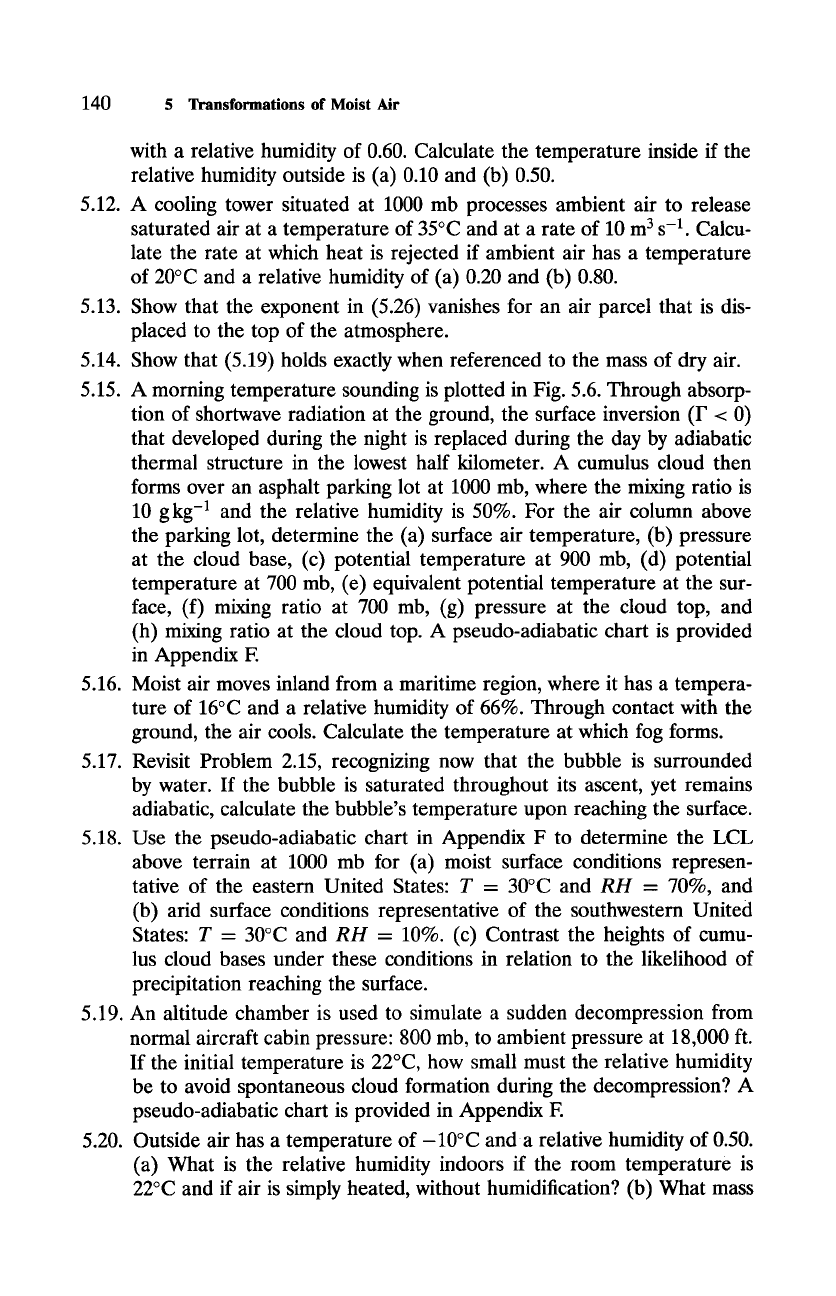
140 5
Transformations of Moist Air
5.12.
5.13.
5.14.
5.15.
5.16.
5.17.
5.18.
5.19.
5.20.
with a relative humidity of 0.60. Calculate the temperature inside if the
relative humidity outside is (a) 0.10 and (b) 0.50.
A cooling tower situated at 1000 mb processes ambient air to release
saturated air at a temperature of 35~ and at a rate of 10 m 3 s -1. Calcu-
late the rate at which heat is rejected if ambient air has a temperature
of 20~ and a relative humidity of (a) 0.20 and (b) 0.80.
Show that the exponent in (5.26) vanishes for an air parcel that is dis-
placed to the top of the atmosphere.
Show that (5.19) holds exactly when referenced to the mass of dry air.
A morning temperature sounding is plotted in Fig. 5.6. Through absorp-
tion of shortwave radiation at the ground, the surface inversion (F < 0)
that developed during the night is replaced during the day by adiabatic
thermal structure in the lowest half kilometer. A cumulus cloud then
forms over an asphalt parking lot at 1000 mb, where the mixing ratio is
10 g kg -1 and the relative humidity is 50%. For the air column above
the parking lot, determine the (a) surface air temperature, (b) pressure
at the cloud base, (c) potential temperature at 900 mb, (d) potential
temperature at 700 mb, (e) equivalent potential temperature at the sur-
face, (f) mixing ratio at 700 mb, (g) pressure at the cloud top, and
(h) mixing ratio at the cloud top. A pseudo-adiabatic chart is provided
in Appendix F.
Moist air moves inland from a maritime region, where it has a tempera-
ture of 16~ and a relative humidity of 66%. Through contact with the
ground, the air cools. Calculate the temperature at which fog forms.
Revisit Problem 2.15, recognizing now that the bubble is surrounded
by water. If the bubble is saturated throughout its ascent, yet remains
adiabatic, calculate the bubble's temperature upon reaching the surface.
Use the pseudo-adiabatic chart in Appendix F to determine the LCL
above terrain at 1000 mb for (a) moist surface conditions represen-
tative of the eastern United States: T = 30~ and
RH
= 70%, and
(b) arid surface conditions representative of the southwestern United
States: T - 30~ and
RH
= 10%. (c) Contrast the heights of cumu-
lus cloud bases under these conditions in relation to the likelihood of
precipitation reaching the surface.
An altitude chamber is used to simulate a sudden decompression from
normal aircraft cabin pressure: 800 mb, to ambient pressure at 18,000 ft.
If the initial temperature is 22~ how small must the relative humidity
be to avoid spontaneous cloud formation during the decompression? A
pseudo-adiabatic chart is provided in Appendix F.
Outside air has a temperature of -10~ and a relative humidity of 0.50.
(a) What is the relative humidity indoors if the room temperature is
22~ and if air is simply heated, without humidification? (b) What mass
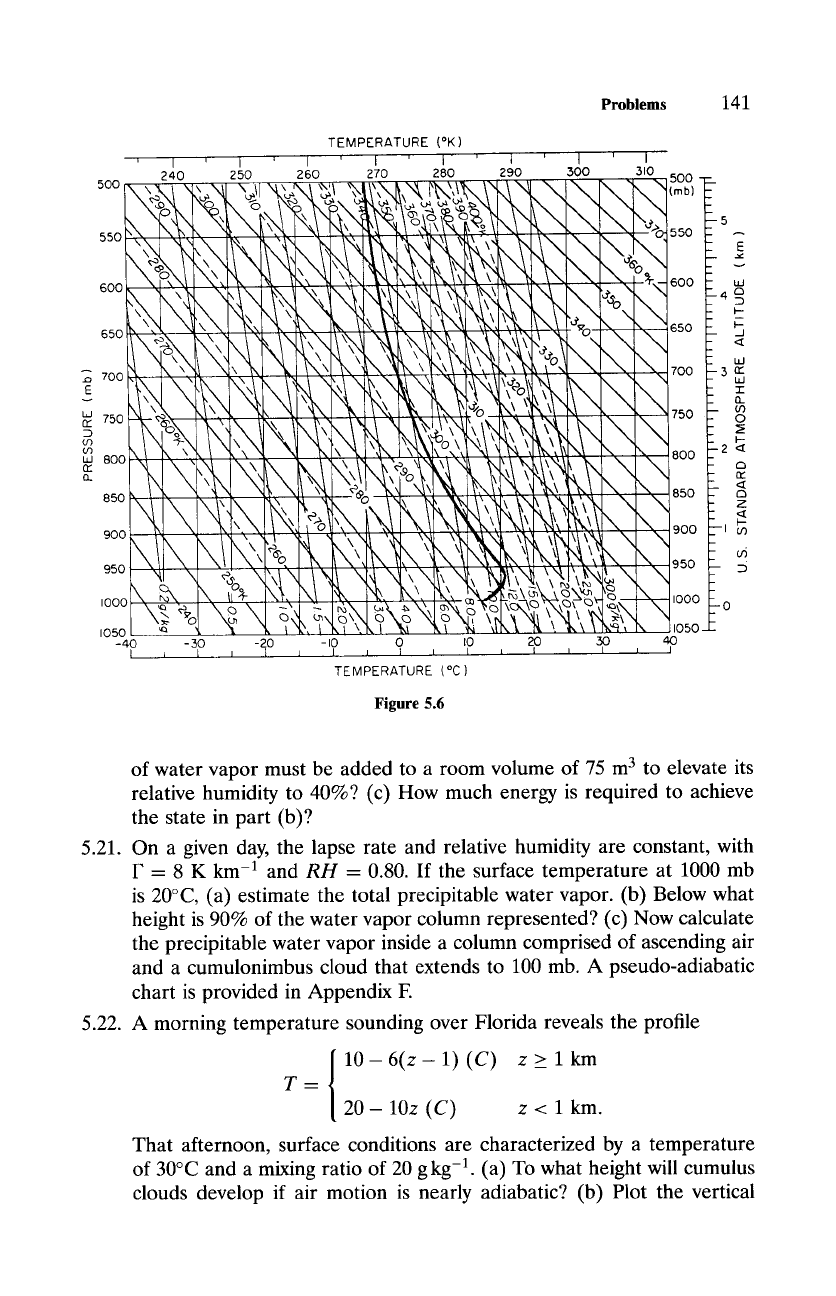
Problems
141
TEMPERATURE (~
I ' l ' I ' I ' I I I ' I
240 250 260 270 280 290 300 310
550 \ " " " - "-"
_ ._~
- ta.I
600 \ 4 C3
D
F-
_
"' 75o ',
. b,,\.
~',
o "x .. ~ \ .\ X e5o -
\\ \' 900 I tO
\ " " "
l,"k
~i\ \
_ c6
950 " :5
a
\X"L
,3~
2,? ~,
",i'.,A & '\'i', '~ ~'\ \
1050
"
&-&"s "
\
1050
-40 -
30
-20 -I0 0 I0 20 30 40
I ~ I ~ I ~ 1 ~ I ~ 1 t I ~ I ~ ,J
TEMPERATURE (~
Figure
5.6
of water vapor must be added to a room volume of 75 m 3 to elevate its
relative humidity to 40%? (c) How much energy is required to achieve
the state in part (b)?
5.21. On a given day, the lapse rate and relative humidity are constant, with
F = 8 K
km -1 and
RH
= 0.80. If the surface temperature at 1000 mb
is 20~ (a) estimate the total precipitable water vapor. (b) Below what
height is 90% of the water vapor column represented? (c) Now calculate
the precipitable water vapor inside a column comprised of ascending air
and a cumulonimbus cloud that extends to 100 mb. A pseudo-adiabatic
chart is provided in Appendix E
5.22. A morning temperature sounding over Florida reveals the profile
T- [10-6(z-1)(C) z>_lkm
/
20- 10z (C) z < 1 km.
That afternoon, surface conditions are characterized by a temperature
of 30~ and a mixing ratio of 20 g kg -1. (a) To what height will cumulus
clouds develop if air motion is nearly adiabatic? (b) Plot the vertical
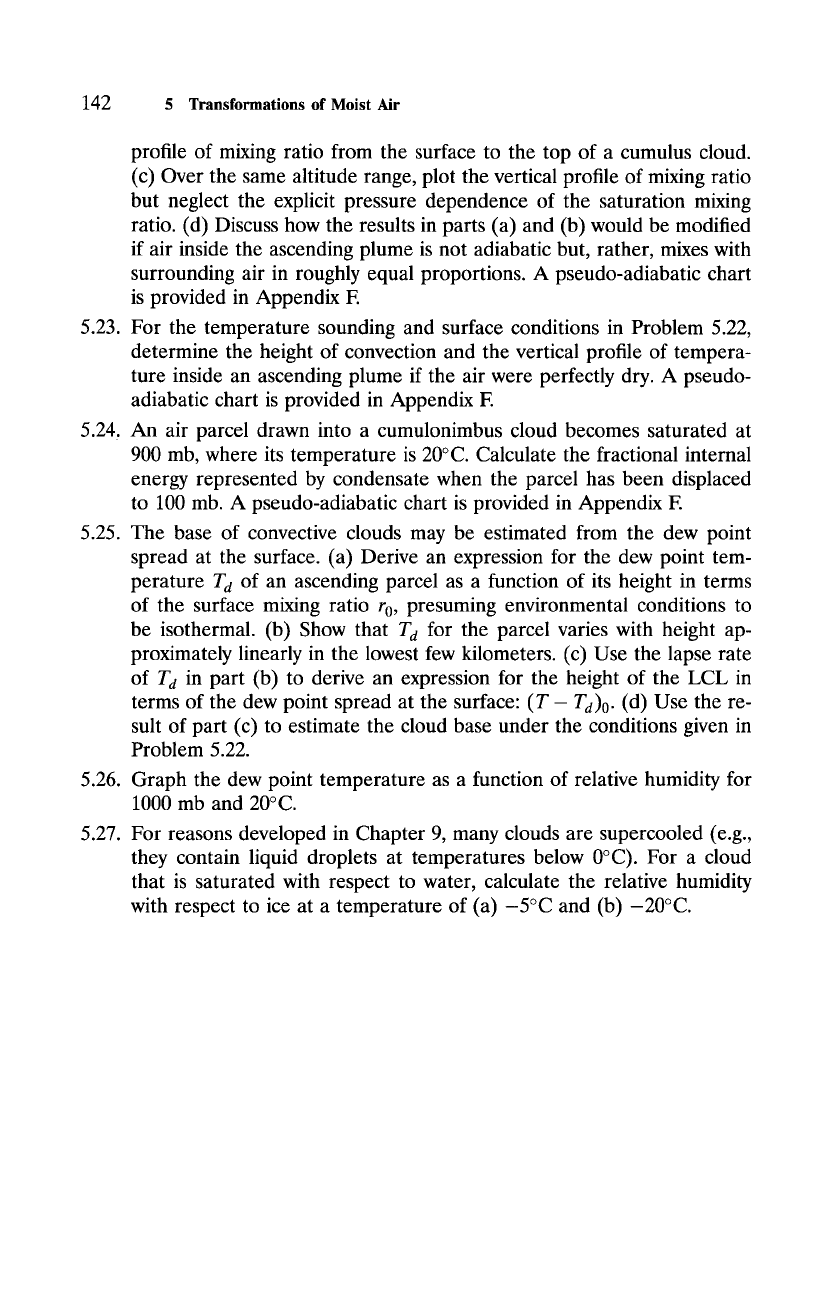
142 5 Transformations of Moist Air
5.23.
5.24.
5.25.
5.26.
5.27.
profile of mixing ratio from the surface to the top of a cumulus cloud.
(c) Over the same altitude range, plot the vertical profile of mixing ratio
but neglect the explicit pressure dependence of the saturation mixing
ratio. (d) Discuss how the results in parts (a) and (b) would be modified
if air inside the ascending plume is not adiabatic but, rather, mixes with
surrounding air in roughly equal proportions. A pseudo-adiabatic chart
is provided in Appendix F.
For the temperature sounding and surface conditions in Problem 5.22,
determine the height of convection and the vertical profile of tempera-
ture inside an ascending plume if the air were perfectly dry. A pseudo-
adiabatic chart is provided in Appendix F.
An air parcel drawn into a cumulonimbus cloud becomes saturated at
900 mb, where its temperature is 20~ Calculate the fractional internal
energy represented by condensate when the parcel has been displaced
to 100 mb. A pseudo-adiabatic chart is provided in Appendix F.
The base of convective clouds may be estimated from the dew point
spread at the surface. (a) Derive an expression for the dew point tem-
perature
T d
of an ascending parcel as a function of its height in terms
of the surface mixing ratio r 0, presuming environmental conditions to
be isothermal. (b) Show that
T d
for the parcel varies with height ap-
proximately linearly in the lowest few kilometers. (c) Use the lapse rate
of
T d
in part (b) to derive an expression for the height of the LCL in
terms of the dew point spread at the surface:
(T- Td) o.
(d) Use the re-
sult of part (c) to estimate the cloud base under the conditions given in
Problem 5.22.
Graph the dew point temperature as a function of relative humidity for
1000 mb and 20 ~
For reasons developed in Chapter 9, many clouds are supercooled (e.g.,
they contain liquid droplets at temperatures below 0~ For a cloud
that is saturated with respect to water, calculate the relative humidity
with respect to ice at a temperature of (a) -5~ and (b) -20~
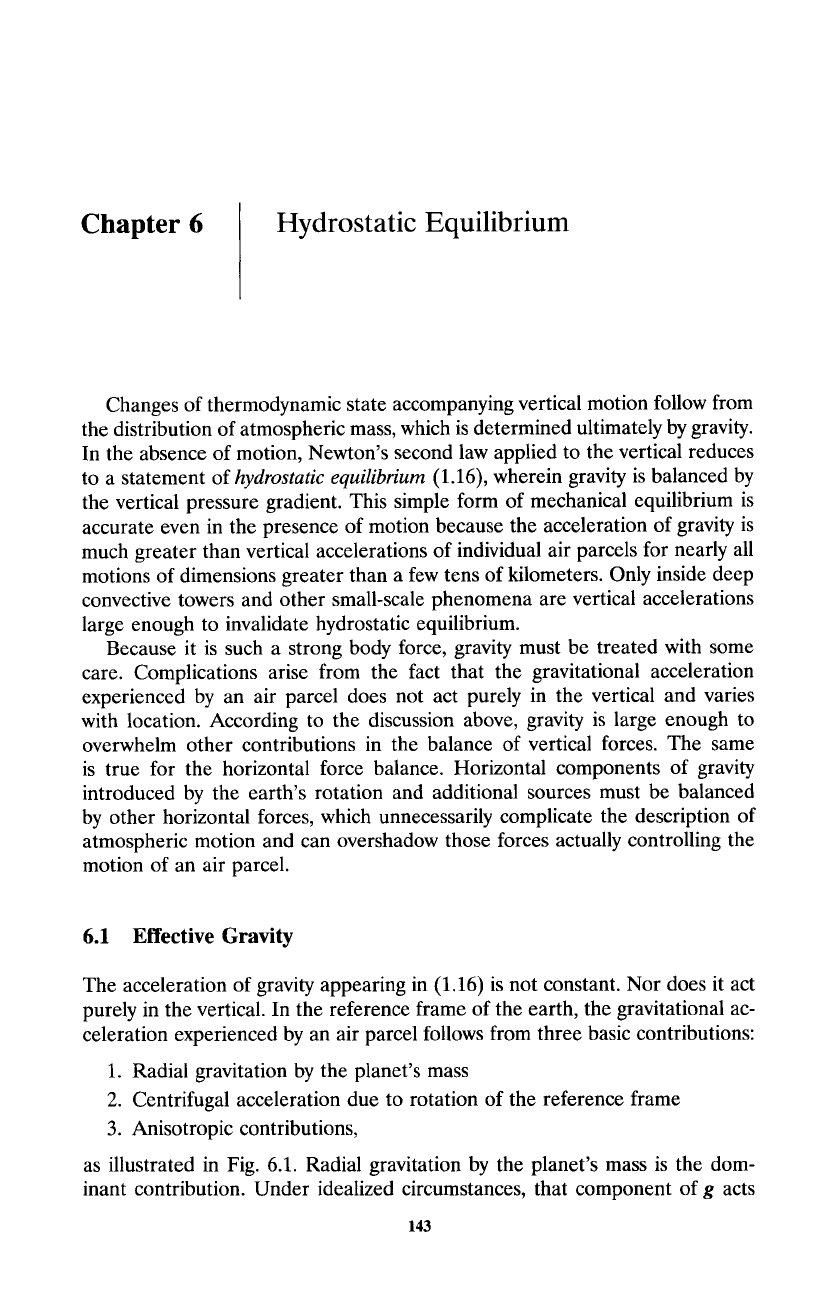
Chapter 6
Hydrostatic Equilibrium
Changes of thermodynamic state accompanying vertical motion follow from
the distribution of atmospheric mass, which is determined ultimately by gravity.
In the absence of motion, Newton's second law applied to the vertical reduces
to a statement of
hydrostatic equilibrium
(1.16), wherein gravity is balanced by
the vertical pressure gradient. This simple form of mechanical equilibrium is
accurate even in the presence of motion because the acceleration of gravity is
much greater than vertical accelerations of individual air parcels for nearly all
motions of dimensions greater than a few tens of kilometers. Only inside deep
convective towers and other small-scale phenomena are vertical accelerations
large enough to invalidate hydrostatic equilibrium.
Because it is such a strong body force, gravity must be treated with some
care. Complications arise from the fact that the gravitational acceleration
experienced by an air parcel does not act purely in the vertical and varies
with location. According to the discussion above, gravity is large enough to
overwhelm other contributions in the balance of vertical forces. The same
is true for the horizontal force balance. Horizontal components of gravity
introduced by the earth's rotation and additional sources must be balanced
by other horizontal forces, which unnecessarily complicate the description of
atmospheric motion and can overshadow those forces actually controlling the
motion of an air parcel.
6.1 Effective Gravity
The acceleration of gravity appearing in (1.16) is not constant. Nor does it act
purely in the vertical. In the reference frame of the earth, the gravitational ac-
celeration experienced by an air parcel follows from three basic contributions:
1. Radial gravitation by the planet's mass
2. Centrifugal acceleration due to rotation of the reference frame
3. Anisotropic contributions,
as illustrated in Fig. 6.1. Radial gravitation by the planet's mass is the dom-
inant contribution. Under idealized circumstances, that component of g acts
143
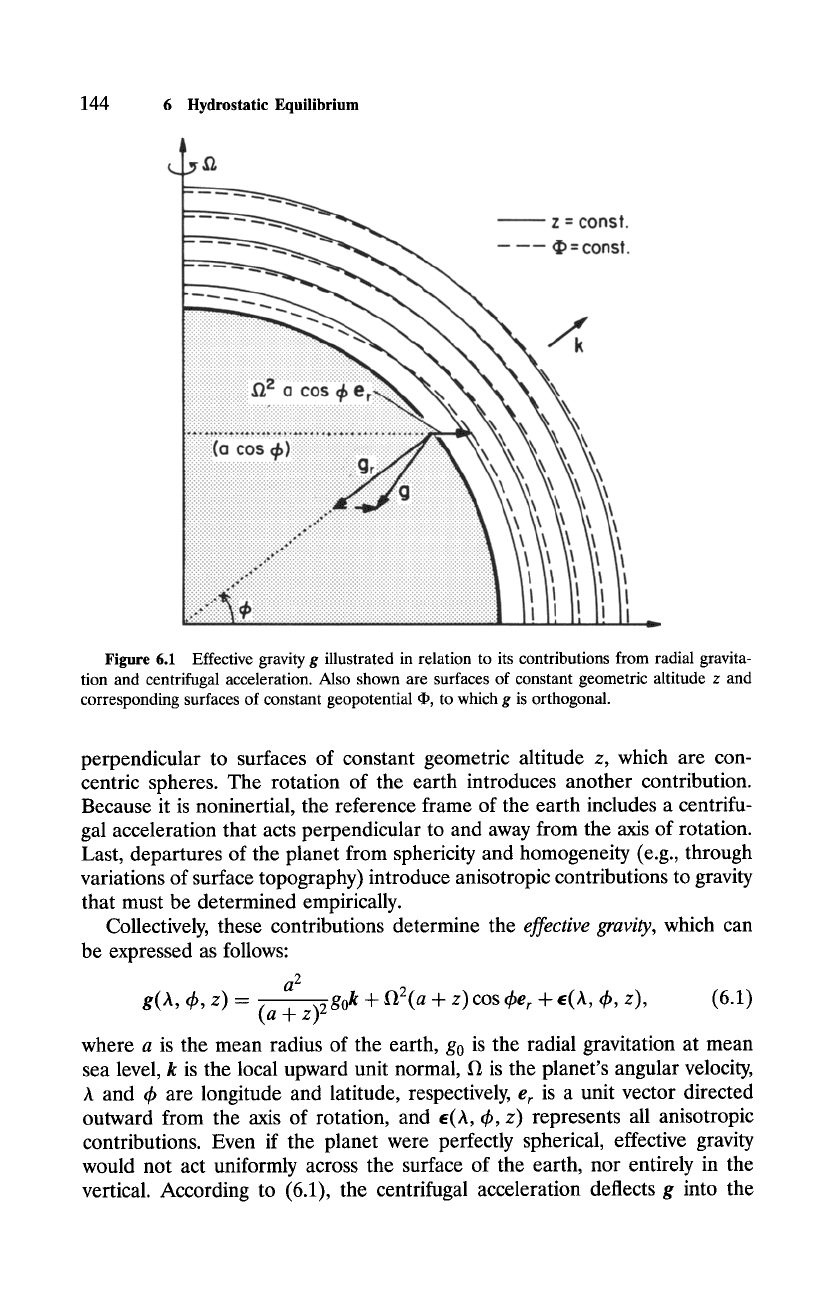
144
6 Hydrostatic Equilibrium
---'--- z = con st.
= const.
iii iiiiiiiil .................... !i!i!i!i!i!i!!!i!i!i!i!i!i!i!i!i
..............
(o cos
,/,)
................
...................•.....•.p.......................................................................................................................•.•
i:i:i:i:i:i:i:i:i:i:~:i:i:i:i:i:i:i:i:i:i:i:i:i:i:i:i:i:i:i:i:i:i:i:i:i:i:i:i:i:i:i:i:i:i:i:i:i:i:i:i:i:i:i:i:i:i:i:i:i:i:i:i:!:i:!:i:!:!:i:!:!::
!ii! i!ii ii~ i~i!i ~ iiiiii!iiiii iiiii!i!iii!i!!iii !iii !ii! !iii !ii!iiiiiii!i!i!i !i ii!i iii ii !i !i iii !iii iii ii ii ii ii ii ii ii ii iii i iii i ii!iiiiiiii! iii! iii! !ii! !ii!!i i!i i i!i i iii i i!i i iiii! !iii !iiiiii!i ii! ! ii!ii!!i i!iii! i iiiiii!ii!!iii!ii! !ii!iiii!iii
f
Figure 6.1 Effective gravity g illustrated in relation to its contributions from radial gravita-
tion and centrifugal acceleration. Also shown are surfaces of constant geometric altitude z and
corresponding surfaces of constant geopotential ~, to which g is orthogonal.
perpendicular to surfaces of constant geometric altitude z, which are con-
centric spheres. The rotation of the earth introduces another contribution.
Because it is noninertial, the reference frame of the earth includes a centrifu-
gal acceleration that acts perpendicular to and away from the axis of rotation.
Last, departures of the planet from sphericity and homogeneity (e.g., through
variations of surface topography) introduce anisotropic contributions to gravity
that must be determined empirically.
Collectively, these contributions determine the
effective gravity,
which can
be expressed as follows:
a 2
g(A,
q~, z) = (a + z) 2gOk +
~2(a + z)cos
dpe r
+ ~(A, q~, z),
(6.1)
where a is the mean radius of the earth, go is the radial gravitation at mean
sea level, k is the local upward unit normal, l~ is the planet's angular velocity,
A and ~b are longitude and latitude, respectively,
e r
is a unit vector directed
outward from the axis of rotation, and ~(A, ~b, z) represents all anisotropic
contributions. Even if the planet were perfectly spherical, effective gravity
would not act uniformly across the surface of the earth, nor entirely in the
vertical. According to (6.1), the centrifugal acceleration deflects g into the
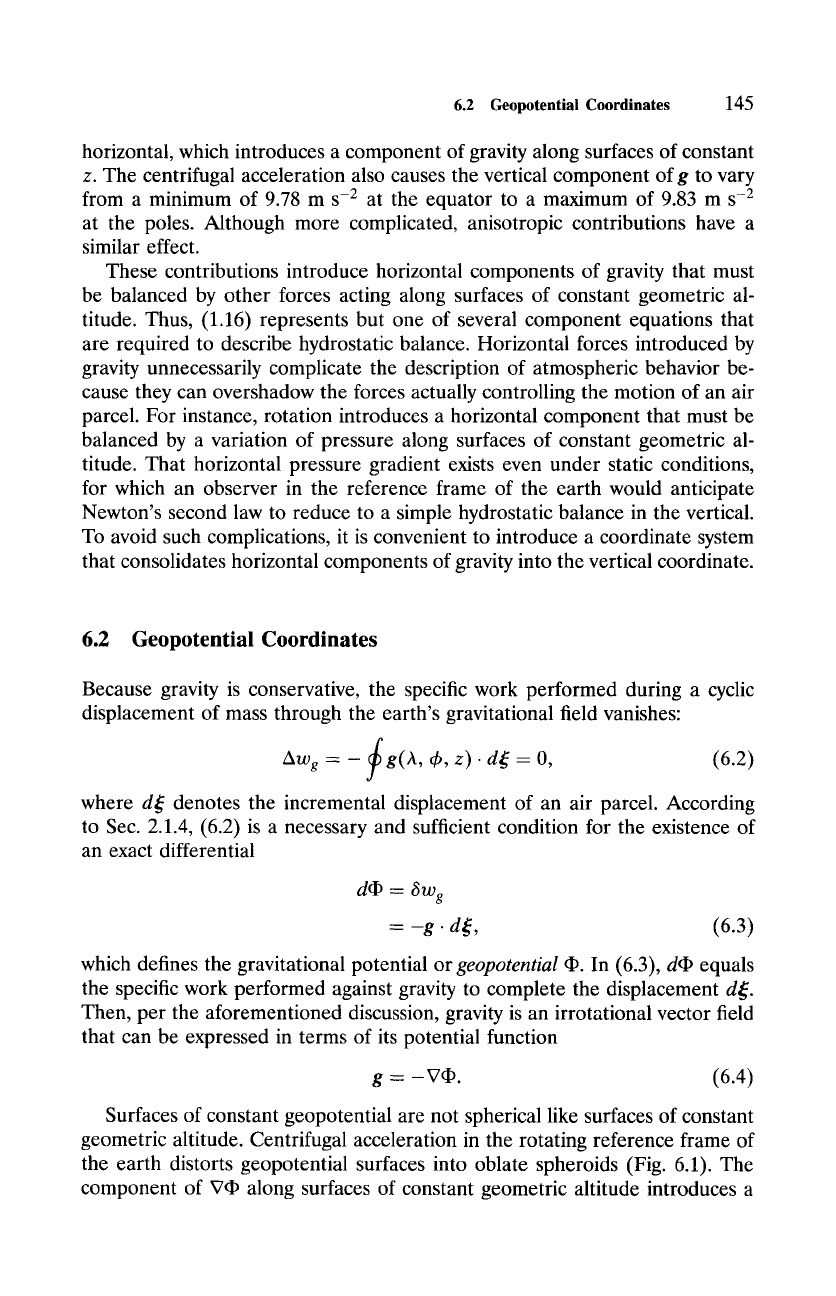
6.2 Geopotential Coordinates
145
horizontal, which introduces a component of gravity along surfaces of constant
z. The centrifugal acceleration also causes the vertical component of g to vary
from a minimum of 9.78 m s -2 at the equator to a maximum of 9.83 m s -2
at the poles. Although more complicated, anisotropic contributions have a
similar effect.
These contributions introduce horizontal components of gravity that must
be balanced by other forces acting along surfaces of constant geometric al-
titude. Thus, (1.16) represents but one of several component equations that
are required to describe hydrostatic balance. Horizontal forces introduced by
gravity unnecessarily complicate the description of atmospheric behavior be-
cause they can overshadow the forces actually controlling the motion of an air
parcel. For instance, rotation introduces a horizontal component that must be
balanced by a variation of pressure along surfaces of constant geometric al-
titude. That horizontal pressure gradient exists even under static conditions,
for which an observer in the reference frame of the earth would anticipate
Newton's second law to reduce to a simple hydrostatic balance in the vertical.
To avoid such complications, it is convenient to introduce a coordinate system
that consolidates horizontal components of gravity into the vertical coordinate.
6.2 Geopotential Coordinates
Because gravity is conservative, the specific work performed during a cyclic
displacement of mass through the earth's gravitational field vanishes:
Awg = - f
g(A, 4', z)-d~ - 0, (6.2)
where ds denotes the incremental displacement of an air parcel. According
to Sec. 2.1.4, (6.2) is a necessary and sufficient condition for the existence of
an exact differential
dap = 6wg
- -g. dg,
(6.3)
which defines the gravitational potential or
geopotential ~.
In (6.3), d~ equals
the specific work performed against gravity to complete the displacement d~.
Then, per the aforementioned discussion, gravity is an irrotational vector field
that can be expressed in terms of its potential function
g = -V~. (6.4)
Surfaces of constant geopotential are not spherical like surfaces of constant
geometric altitude. Centrifugal acceleration in the rotating reference flame of
the earth distorts geopotential surfaces into oblate spheroids (Fig. 6.1). The
component of XT~ along surfaces of constant geometric altitude introduces a
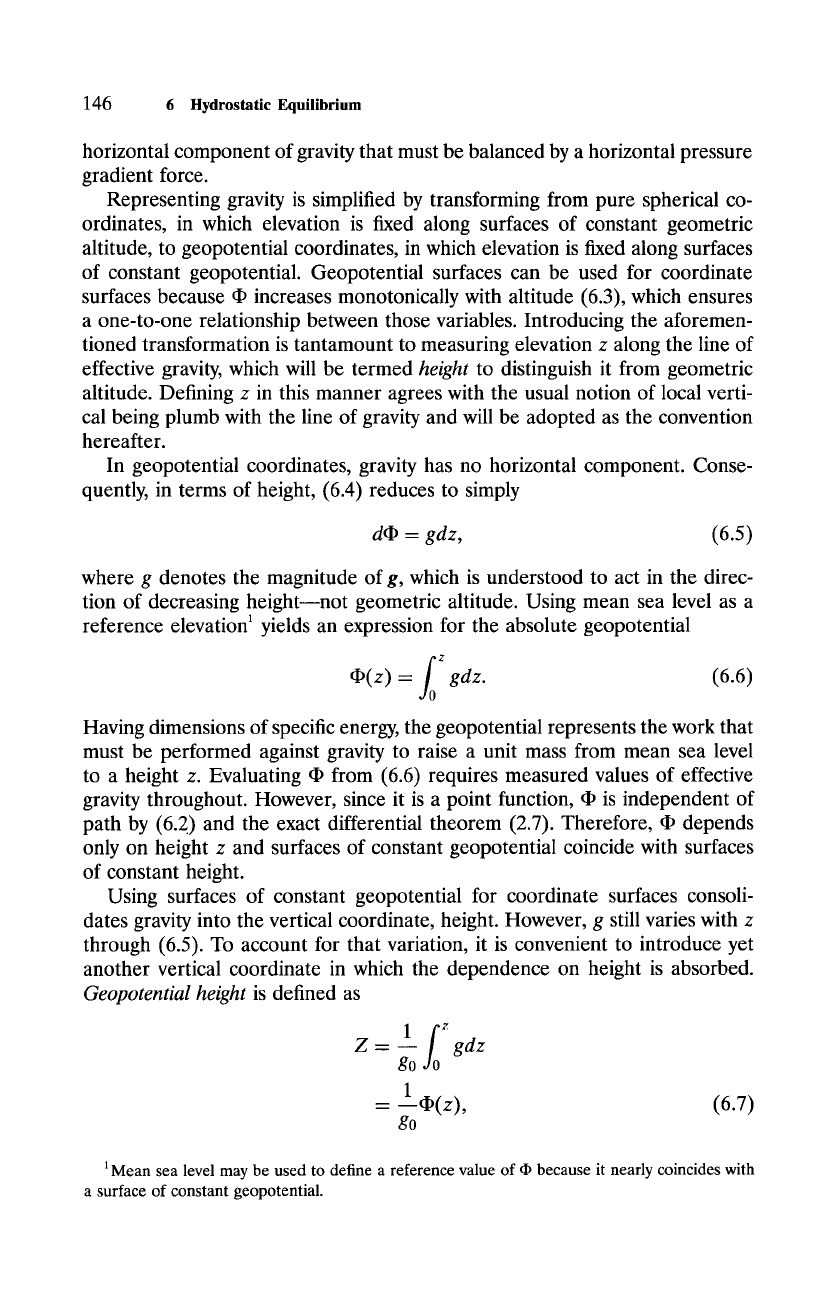
146
6
Hydrostatic Equilibrium
horizontal component of gravity that must be balanced by a horizontal pressure
gradient force.
Representing gravity is simplified by transforming from pure spherical co-
ordinates, in which elevation is fixed along surfaces of constant geometric
altitude, to geopotential coordinates, in which elevation is fixed along surfaces
of constant geopotential. Geopotential surfaces can be used for coordinate
surfaces because 9 increases monotonically with altitude (6.3), which ensures
a one-to-one relationship between those variables. Introducing the aforemen-
tioned transformation is tantamount to measuring elevation z along the line of
effective gravity, which will be termed
height
to distinguish it from geometric
altitude. Defining z in this manner agrees with the usual notion of local verti-
cal being plumb with the line of gravity and will be adopted as the convention
hereafter.
In geopotential coordinates, gravity has no horizontal component. Conse-
quently, in terms of height, (6.4) reduces to simply
ddO - gdz,
(6.5)
where g denotes the magnitude of g, which is understood to act in the direc-
tion of decreasing heightmnot geometric altitude. Using mean sea level as a
reference elevation I yields an expression for the absolute geopotential
f0 Z
r = gdz.
~ (6.6)
Having dimensions of specific energy, the geopotential represents the work that
must be performed against gravity to raise a unit mass from mean sea level
to a height z. Evaluating 9 from (6.6) requires measured values of effective
gravity throughout. However, since it is a point function, 9 is independent of
path by (6.2) and the exact differential theorem (2.7). Therefore, 9 depends
only on height z and surfaces of constant geopotential coincide with surfaces
of constant height.
Using surfaces of constant geopotential for coordinate surfaces consoli-
dates gravity into the vertical coordinate, height. However, g still varies with z
through (6.5). To account for that variation, it is convenient to introduce yet
another vertical coordinate in which the dependence on height is absorbed.
Geopotential height
is defined as
Z= l f0 ~'
m gdz
go
1
=
go
(6.7)
1Mean sea level may be used to define a reference value of 9 because it nearly coincides with
a surface of constant geopotential.
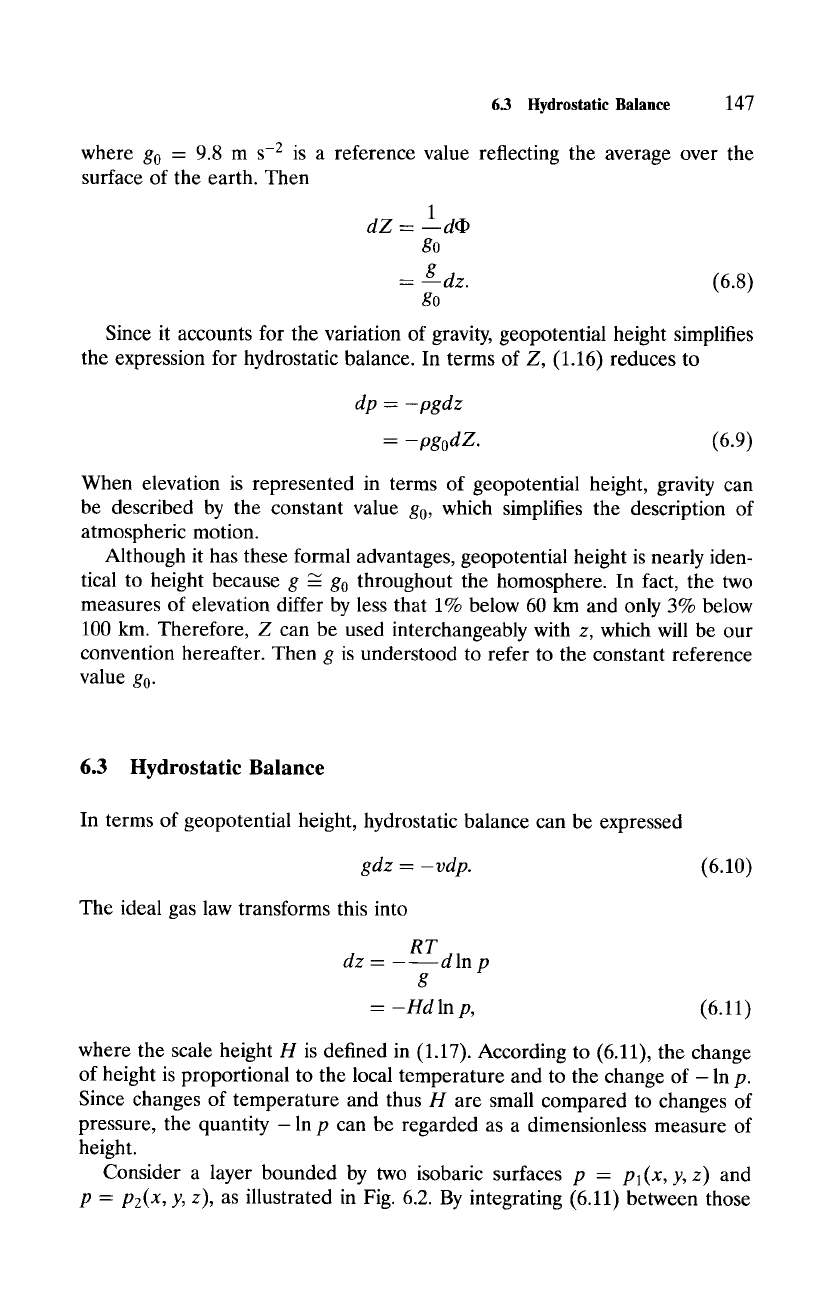
6.3 Hydrostatic Balance
147
where go - 9.8
m s -2
is a reference value reflecting the average over the
surface of the earth. Then
dZ - ml d~
go
= g dz.
(6.8)
go
Since it accounts for the variation of gravity, geopotential height simplifies
the expression for hydrostatic balance. In terms of Z, (1.16) reduces to
dp - -pgdz
= -pgodZ.
(6.9)
When elevation is represented in terms of geopotential height, gravity can
be described by the constant value go, which simplifies the description of
atmospheric motion.
Although it has these formal advantages, geopotential height is nearly iden-
tical to height because g ~ go throughout the homosphere. In fact, the two
measures of elevation differ by less that 1% below 60 km and only 3% below
100 km. Therefore, Z can be used interchangeably with z, which will be our
convention hereafter. Then g is understood to refer to the constant reference
value go.
6.3 Hydrostatic Balance
In terms of geopotential height, hydrostatic balance can be expressed
gdz = -vdp.
(6.10)
The ideal gas law transforms this into
RT
dz
= -~dln p
= -Hdln p,
(6.11)
where the scale height H is defined in (1.17). According to (6.11), the change
of height is proportional to the local temperature and to the change of- In p.
Since changes of temperature and thus H are small compared to changes of
pressure, the quantity -In p can be regarded as a dimensionless measure of
height.
Consider a layer bounded by two isobaric surfaces p =
pl(x, y, z)
and
p = p2(x, y, z),
as illustrated in Fig. 6.2. By integrating (6.11) between those
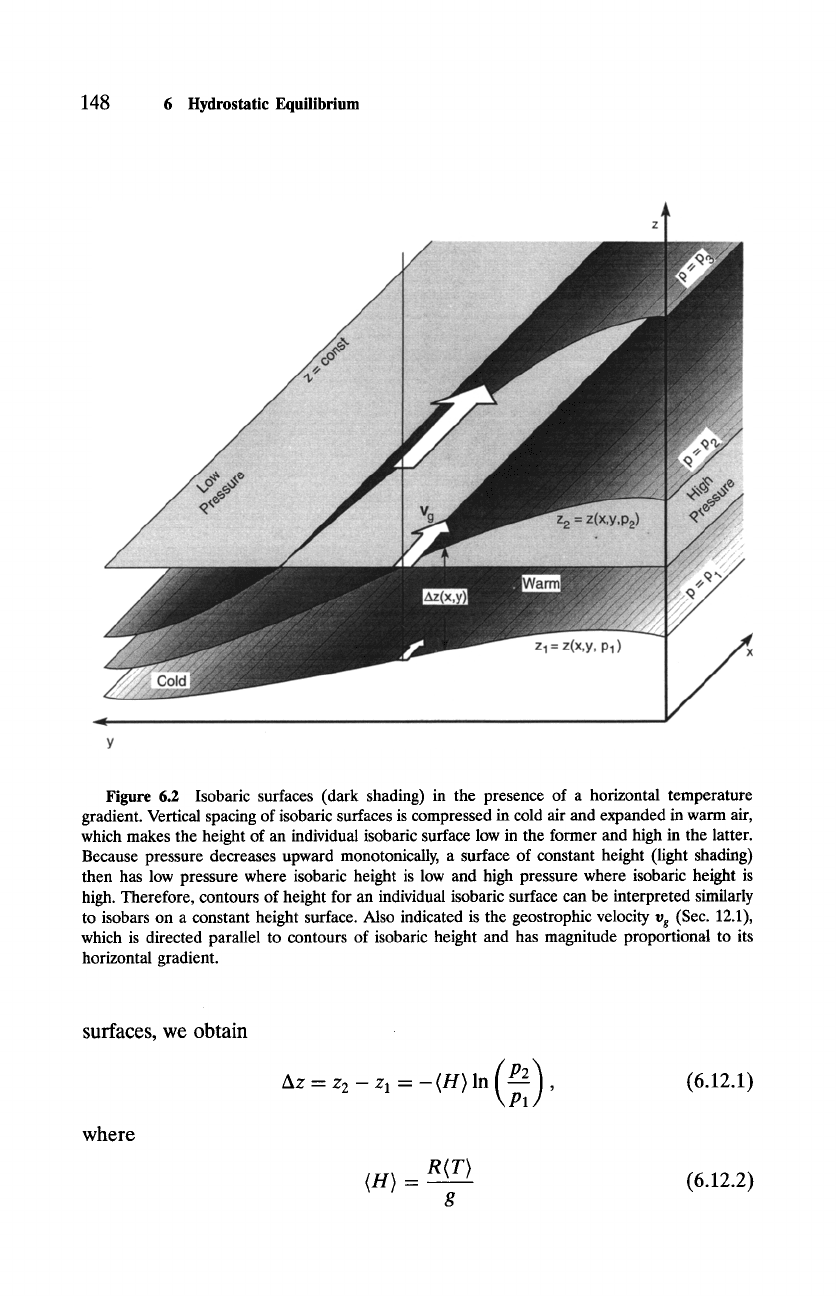
148
6 Hydrostatic Equilibrium
-. ,,
Zl: z(x,y, Pl)
I fx
Figure 6.2 Isobaric surfaces (dark shading) in the presence of a horizontal temperature
gradient. Vertical spacing of isobaric surfaces is compressed in cold air and expanded in warm air,
which makes the height of an individual isobaric surface low in the former and high in the latter.
Because pressure decreases upward monotonically, a surface of constant height (light shading)
then has low pressure where isobaric height is low and high pressure where isobaric height is
high. Therefore, contours of height for an individual isobaric surface can be interpreted similarly
to isobars on a constant height surface. Also indicated is the geostrophic velocity
vg
(Sec. 12.1),
which is directed parallel to contours of isobaric height and has magnitude proportional to its
horizontal gradient.
surfaces, we obtain
where
Az-- z 2 -- z I = -(n)In
~1
'
(6.12.1)
(H) = R,_ ,IT~
(6.12.2)
g
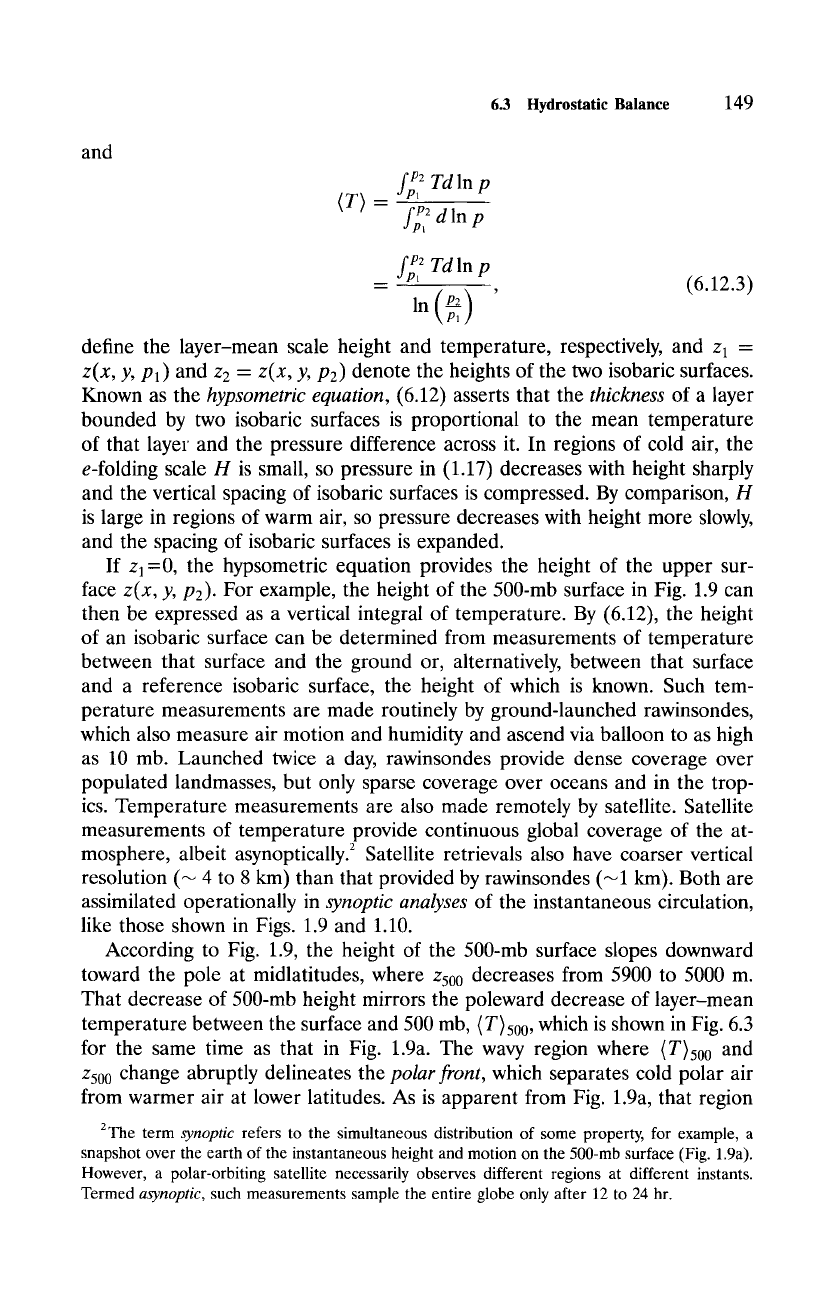
6.3
Hydrostatic Balance
149
and
(T) - fpp2 Tdlnp
fp7 dlnp
_- fpPl ~ Tdln p
(6.12.3)
ln(~) '
define the layer-mean scale height and temperature, respectively, and Zl =
z(x, y,
Pl)
and z2 =
z(x, y,
P2) denote the heights of the two isobaric surfaces.
Known as the
hypsometric equation,
(6.12) asserts that the
thickness
of a layer
bounded by two isobaric surfaces is proportional to the mean temperature
of that layer and the pressure difference across it. In regions of cold air, the
e-folding scale H is small, so pressure in (1.17) decreases with height sharply
and the vertical spacing of isobaric surfaces is compressed. By comparison, H
is large in regions of warm air, so pressure decreases with height more slowly,
and the spacing of isobaric surfaces is expanded.
If zl =0, the hypsometric equation provides the height of the upper sur-
face
z(x, y,
P2). For example, the height of the 500-mb surface in Fig. 1.9 can
then be expressed as a vertical integral of temperature. By (6.12), the height
of an isobaric surface can be determined from measurements of temperature
between that surface and the ground or, alternatively, between that surface
and a reference isobaric surface, the height of which is known. Such tem-
perature measurements are made routinely by ground-launched rawinsondes,
which also measure air motion and humidity and ascend via balloon to as high
as 10 mb. Launched twice a day, rawinsondes provide dense coverage over
populated landmasses, but only sparse coverage over oceans and in the trop-
ics. Temperature measurements are also made remotely by satellite. Satellite
measurements of temperature provide continuous global coverage of the at-
mosphere, albeit asynoptically. ~ Satellite retrievals also have coarser vertical
resolution (~ 4 to 8 km) than that provided by rawinsondes (~1 km). Both are
assimilated operationally in
synoptic analyses
of the instantaneous circulation,
like those shown in Figs. 1.9 and 1.10.
According to Fig. 1.9, the height of the 500-mb surface slopes downward
toward the pole at midlatitudes, where zs00 decreases from 5900 to 5000 m.
That decrease of 500-mb height mirrors the poleward decrease of layer-mean
temperature between the surface and 500 mb, (T)500, which is shown in Fig. 6.3
for the same time as that in Fig. 1.9a. The wavy region where (T)500 and
zs00 change abruptly delineates the
polar front,
which separates cold polar air
from warmer air at lower latitudes. As is apparent from Fig. 1.9a, that region
2The term
synoptic
refers to the simultaneous distribution of some property, for example, a
snapshot over the earth of the instantaneous height and motion on the 500-mb surface (Fig. 1.9a).
However, a polar-orbiting satellite necessarily observes different regions at different instants.
Termed
asynoptic,
such measurements sample the entire globe only after 12 to 24 hr.
